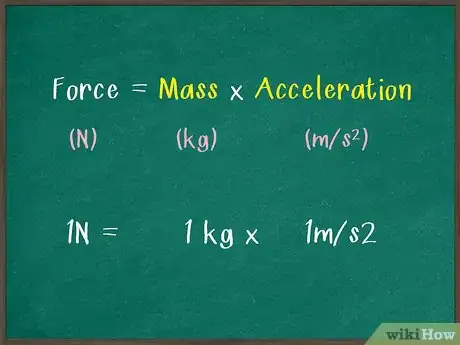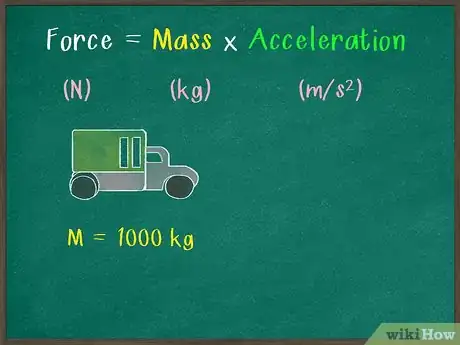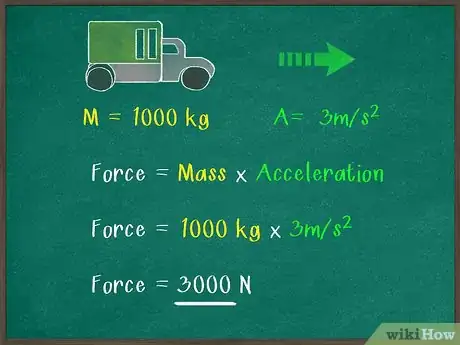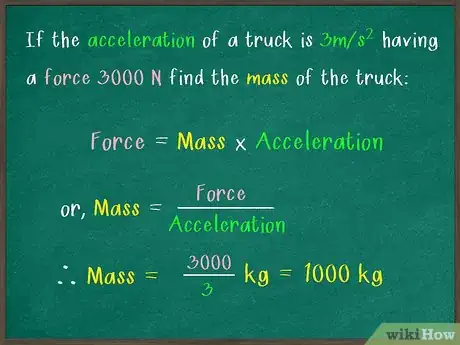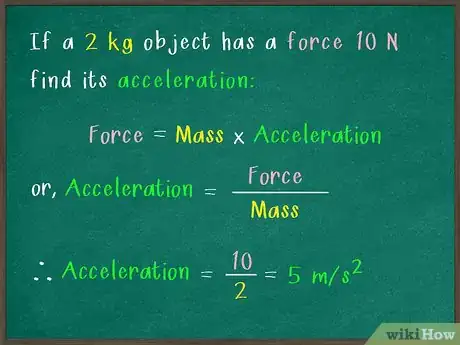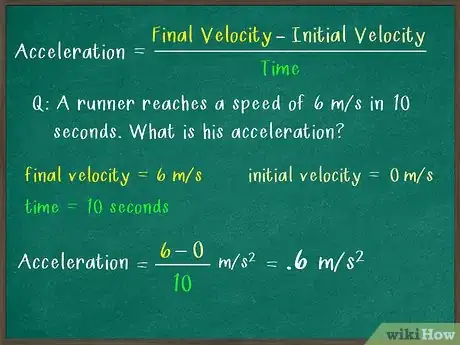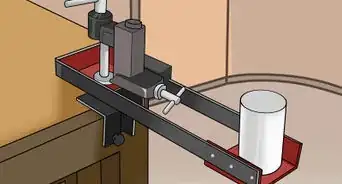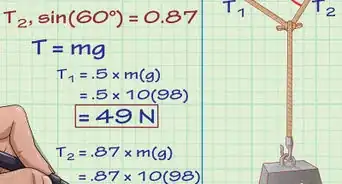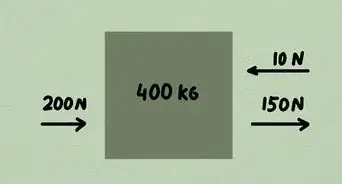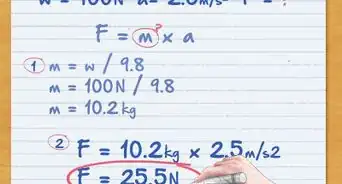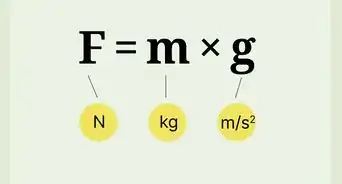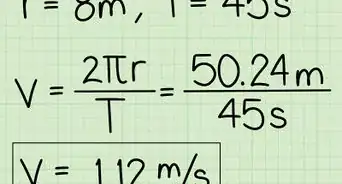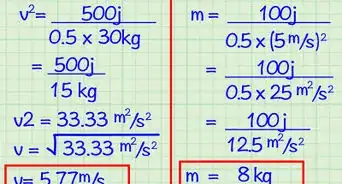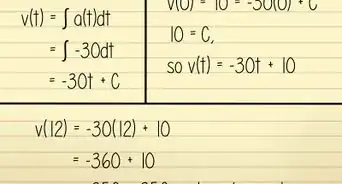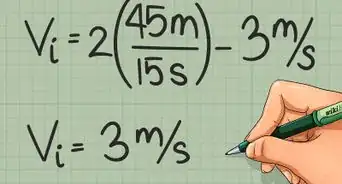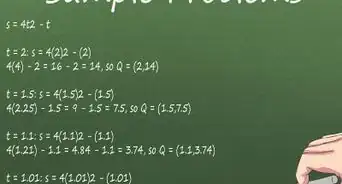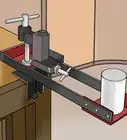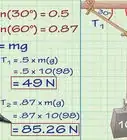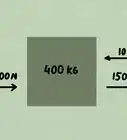wikiHow is a “wiki,” similar to Wikipedia, which means that many of our articles are co-written by multiple authors. To create this article, 20 people, some anonymous, worked to edit and improve it over time.
There are 11 references cited in this article, which can be found at the bottom of the page.
This article has been viewed 162,834 times.
Learn more...
Force is a physics term that is defined as an influence that causes an object to change its rate or direction of movement or rotation. A force can accelerate objects by pulling or pushing them. The relationship between force, mass, and acceleration was defined by Isaac Newton in his second law of motion, which states that an object's force is the product of its mass and acceleration. If you want to know how to measure force, just follow these steps.
Steps
Measure Force
-
1Understand the relationship between force, mass, and acceleration. The force of an object is simply the product of its mass and acceleration.[1] This relationship can be defined by the following formula: Force = Mass x Acceleration. Here are a few other things to keep in mind as you measure force:[2]
- The standard unit for mass is kilograms (kg).
- The standard unit for acceleration is m/s2.
- The standard unit for force is the newton (N). The newton is a derived standard unit. 1N = 1 kg x 1m/s2.
-
2Measure the mass of a given object. An object's mass is the amount of matter that it contains.[3] The mass of an object never changes, no matter what planet it's on; while weight fluctuates depending on gravitational pull, your mass is the same on Earth and on the Moon.[4] In the metric system, mass can be expressed in grams or kilograms. Let's say the object we're working with is a truck that has a mass of 1000 kg.
- To find the mass of a given object, place it on a triple beam or a double pan balance. This will calculate the mass in kilograms or grams.
- In the English system, mass can be expressed in pounds. Because force can also be expressed in pounds, the term "pound-mass" has been coined to distinguish its usage. However, if you find the mass of an object using pounds in the English system, it's best to convert it to the metric system. If you know an object's mass in pounds, simply multiply it by .45 to find the mass in kilograms.
Advertisement -
3Measure the object's acceleration. In physics, acceleration is defined as a change in velocity, which is defined as speed in a given direction, per unit of time.[5] In addition to the common definition of acceleration as speeding up, it also can mean an object is slowing down or changing direction.[6] Just as velocity can be measured with a speedometer, acceleration is measured with an accelerometer. Let's say the acceleration of the 1000 kg truck we're working with is 3m/s2.
- In the metric system, velocity is expressed in centimeters per second or meters per second, and acceleration is expressed as centimeters per second per second (centimeters per second squared) or meters per second per second (meters per second squared).
- In the English system, one way to express velocity is as feet per second, so acceleration can be expressed in feet per second squared.
-
4Multiply the object's mass by its acceleration. This is the force's value. Simply plug in the known numbers into the equation and you will know the force of the object. Remember to state your answer in newtons (Ns).[7]
- Force = Mass x Acceleration
- Force = 1000 kg x 3m/s2
- Force = 3000N
Advanced Concepts
-
1Find mass if you know force and acceleration. If you know the force and acceleration of an object, simply plug them into the same formula to find the object's mass. Here's how to do it:[8]
- Force = Mass x Acceleration
- 3N = Mass x 3m/s2
- Mass = 3N/3m/s2
- Mass = 1 kg
-
2Find acceleration if you know force and mass. If you know the force and mass of an object, simply plug them into the same formula to find the object's mass. Here's how to do it:[9]
- Force = Mass x Acceleration
- 10N = 2 kg x Acceleration
- Acceleration = 10N/2kg
- Acceleration = 5m/s2
-
3Find the acceleration of an object. If you want to find the force of an object, you can calculate its acceleration as long as you know its mass. All you have to do is use the formula for finding the acceleration of an object. The formula is (Acceleration = Final Velocity - Initial Velocity)/Time.[10]
- Example: A runner reaches a speed of 6 m/s in 10 seconds. What is his acceleration?
- The final velocity is 6 m/s. The original velocity is 0 m/s. The time is 10s.
- Acceleration = (6 m/s - 0 m/s)/10s = 6/10s = .6m/s2
Community Q&A
-
QuestionIs it possible to measure the force of a stationary object?
 Community AnswerYes. You can measure the force of gravity pulling the object. Just use the gravitational constant for the acceleration of the object.
Community AnswerYes. You can measure the force of gravity pulling the object. Just use the gravitational constant for the acceleration of the object. -
QuestionWhat is mass movement?
 Community AnswerMass movement is the movement of surface material caused by gravity. Landslides and rockfalls are examples of very sudden movements of this type. Geological agents such as water, wind and ice all work with gravity to cause a leveling of land, too.
Community AnswerMass movement is the movement of surface material caused by gravity. Landslides and rockfalls are examples of very sudden movements of this type. Geological agents such as water, wind and ice all work with gravity to cause a leveling of land, too. -
QuestionWhat is a gravitational force?
 TomPNTop AnswererA force caused by a massive object (as opposed to a massless object). There are various theories as to how gravity works. Newton's is easiest to understand and apply, but more up-to-date theories (such as general relativity) are used when increased accuracy is needed.
TomPNTop AnswererA force caused by a massive object (as opposed to a massless object). There are various theories as to how gravity works. Newton's is easiest to understand and apply, but more up-to-date theories (such as general relativity) are used when increased accuracy is needed.
Things You'll Need
- Balance or spring scale
- Accelerometer
- Pencil and paper or calculator
References
- ↑ https://sciencing.com/what-does-g-force-mean-13710432.html
- ↑ https://www.omnicalculator.com/physics/force
- ↑ https://education.jlab.org/qa/mass_01.html
- ↑ https://www.ducksters.com/science/physics/mass_and_weight.php
- ↑ https://www.bbc.com/bitesize/guides/z2b9hv4/revision/1
- ↑ https://www.physicsclassroom.com/class/1DKin/Lesson-1/Acceleration
- ↑ https://www.bbc.com/bitesize/guides/zxxxdxs/revision/4
- ↑ https://sciencing.com/calculate-mass-weight-6399639.html
- ↑ https://www.omnicalculator.com/physics/acceleration
About This Article
To measure force, look at the formula force equals mass times acceleration (F=M*A). An object’s mass is the amount of matter that it contains and is expressed in grams or kilograms. Acceleration is the change in velocity, which is speed in a given direction, per unit of time. Acceleration is expressed as centimeters per second per second, which is centimeters per second squared. Multiply the object’s mass by its acceleration to find the force’s value, and state your answer in newtons (Ns). If you want to learn how to find the acceleration or mass if you know the force of an object, keep reading the article!
